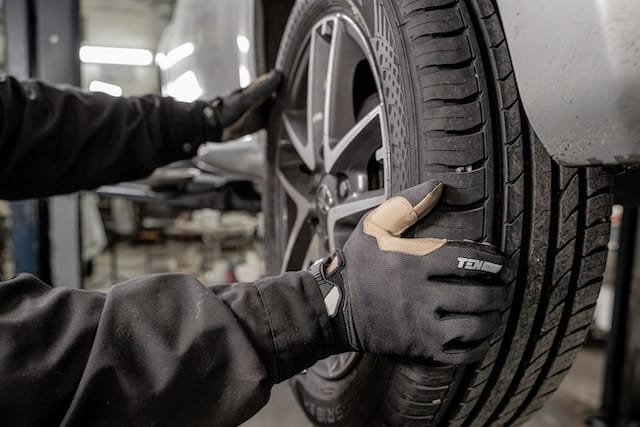
Ever found yourself asking, “how long can you drive on a spare tire?” Well, you’re not alone, and this article is crafted just for you. A common guideline is to drive no more than 70 miles and no faster than 50 miles per hour before replacing your spare tire.
A spare tire, specifically a compact spare, is designed for emergency use and should not be driven on for long distances or at high speeds. They are made for short-term use to get you to a safe location or a nearby auto shop where your flat tire can be repaired or replaced.
The Limits of a Spare Tire
A spare tire, often known as a “donut,” is typically smaller and not as durable as regular tires. These temporary solutions are made with lighter materials and less tread, making them less suitable for long-distance driving or harsh weather conditions.
Risks of Driving on a Spare Tire
Driving on a spare tire for extended periods or at high speeds can be risky. Due to their reduced size and durability, spares do not handle the same way as regular tires. They can adversely affect your car’s handling and stopping distance, which could potentially lead to accidents. Furthermore, driving on a spare tire for longer than recommended could cause damage to other components of your vehicle, such as the differential.
Safety Tips When Driving on a Spare Tire
When you have a spare tire installed, it’s crucial to drive cautiously and consider the following safety tips:
- Drive at reduced speeds: Since spare tires are not built for speed, try to keep your speed under 50 mph.
- Avoid driving long distances: Aim to travel only as far as you need to get your regular tire repaired or replaced, ideally within 70 miles.
- Check tire pressure: Ensure your spare is properly inflated before you start driving.
Regular Tire Maintenance

The best way to avoid relying on a spare tire is to maintain your regular tires. Regular inspections for cuts, punctures, and under-inflation can help you detect problems early and address them promptly, reducing the chance of unexpected flats.
While a spare tire is a handy temporary solution, it’s not a long-term fix. Knowing how long you can drive on a spare tire and understanding the risks of exceeding these limits is crucial for your safety and the health of your vehicle. Always remember, regular tire maintenance is your best line of defense against unexpected flats and the need for a spare.
How to Install a Spare Tire: A Simple Step-by-Step Guide
Step 1: Preparing for the Installation
Before you start, ensure that your vehicle is parked on a flat, stable surface away from traffic. Turn on your hazard lights and apply the parking brake for safety.
Step 2: Removing the Wheel
Locate and remove your vehicle’s lug wrench and jack from the trunk. Use the wrench to loosen the lug nuts on the wheel you’ll be replacing (don’t remove them yet). After that, place the jack under the vehicle’s frame near the wheel you’re changing, and pump or twist it until the wheel is lifted off the ground.
Step 3: Unmounting the Old Tire
Once the wheel is off the ground, fully unscrew the lug nuts and put them aside in a safe place. Grasp the wheel and gently pull it towards you until it’s free from the hub.
Step 4: Installing the Spare Tire
Align the holes of the spare tire with the bolts on the hub. Push the spare onto the hub until it can’t go any further.
Step 5: Securing the Spare Tire
Put the lug nuts back on the bolts and tighten them by hand as much as you can. Then lower the car using the jack until it’s back on the ground.
Step 6: Final Tightening and Checking
Using the lug wrench, tighten the nuts as much as possible. Finally, check the spare tire’s pressure and inflate it to the recommended PSI if necessary.
Remember, the spare tire is a temporary solution. Get your tire fixed or replaced as soon as you can, and drive at a reduced speed while using the spare.
Spare Tires: Frequently Asked Questions (FAQs)

Q: What type of spare tire do compact and midsize cars typically use?
A: Compact and midsize cars usually use compact temporary spares, often referred to as ‘donut’ tires. They are smaller than regular tires and require different tire pressure, typically around 60 PSI.
Q: What type of spare tire is usually found in SUVs, crossovers, and trucks?
A: Larger vehicles like SUVs, crossovers, and trucks often come equipped with a full-size spare tire. They are larger to support the vehicle’s full load and any additional cargo or towed items.
Q: How do full-size spares differ from regular tires?
A: Full-size spares are typically of lesser quality than regular tires, may have narrower wheels, and might not be produced by the same manufacturer as your other tires. Despite being full-sized, they should be replaced as soon as possible.
Q: How can I drive safely on a spare tire?
A: To drive safely on a spare tire, check its pressure regularly, give yourself extra space and time to brake, be extra cautious in inclement weather, and replace the spare when necessary.
Q: Can spare tires affect the anti-lock brake system (ABS)?
A: Yes, using a spare tire can cause your vehicle’s ABS light to turn on or affect its functioning. Donut spares can also lead to inaccuracies in some vehicles’ speedometers.
Q: How long can you drive on a spare tire?
A: The common guideline is to drive no more than 70 miles and no faster than 50 miles per hour on a spare tire.
Q: Why can’t you drive long distances on a spare tire?
A: Spare tires, especially the smaller “donut” types, are not designed for long-distance driving. They’re made from lighter materials with less tread, making them less sturdy and safe for prolonged use.
Q: What are the risks of driving too long on a spare tire?
A: Extended driving on a spare can lead to poor car handling, increased stopping distances, and possible damage to other car components, such as the differential.
Q: Can I drive on the highway with a spare tire?
A: While it’s possible, it’s not advisable to drive at high speeds with a spare tire. They’re designed for short distances at reduced speeds to get you to a safe location or repair shop.
Q: How can I avoid having to use a spare tire?
A: Regular tire maintenance, including frequent inspections for cuts, punctures, and ensuring proper tire pressure, can help detect issues early, reducing the chances of a flat tire.
Q: Is the spare tire’s pressure different from regular tires?
A: Yes, compact spare tires often require a higher inflation pressure than regular tires – typically around 60 psi. Always check the recommended tire pressure label on the spare tire.
Q: How often should I replace my spare tire?
A: Even if unused, a spare tire should be replaced every six to ten years due to the rubber’s degradation over time. However, consult your vehicle’s manual for specific recommendations.
Q: Does every car come with a spare tire?
A: Not necessarily. While many vehicles do come equipped with a spare tire, some newer models may not. Instead, they may have run-flat tires or a tire repair kit.
Q: What if my car doesn’t have a spare tire?
A: If your vehicle doesn’t come with a spare, it’s recommended to invest in a roadside assistance service or carry a tire puncture repair kit and a portable tire inflator.
Q: Can I replace my donut spare with a full-size spare?
A: Yes, if your vehicle has enough room in the spare tire compartment. Having a full-size spare tire is a good idea if you frequently travel long distances.
Q: Do spare tires have the same tread depth as regular tires?
A: No, spare tires usually have less tread depth compared to regular tires as they are not designed for extended use.
Q: Why do spare tires have a higher susceptibility to slipping or hydroplaning?
A: Spare tires, particularly donut spares, don’t have advanced treads like regular tires, making them less capable of providing traction. As a result, they are more susceptible to slipping or hydroplaning in wet conditions.
Q: Are spare tires more susceptible to damage when stored underneath the vehicle?
A: Yes, full-size spares stored underneath the vehicle can be exposed to harsher elements, potentially causing faster wear and tear. Regular inspection is recommended.
Q: Can I use my full-size spare tire as a regular tire?
A: Although it’s possible, full-size spares are not designed for prolonged use as they may lack the durability and certain features of regular tires. It’s best to replace the damaged tire as soon as possible.
Q: Can you fix a flat spare tire?
A: Yes, a flat spare tire can often be repaired, unless it’s seriously damaged. However, it’s always best to consult with a professional.
Q: Can I use the spare tire of another vehicle?
A: It’s generally not recommended as the tire might not fit properly, which could compromise safety. Always use the spare tire designed for your specific vehicle model.
Q: Can I tow my vehicle with a spare tire on?
A: While it’s technically possible, it’s not advisable due to the lower durability and speed limitations of a spare tire. Professional towing service is recommended in such situations.
Q: How does a spare tire affect the towing capacity of my vehicle?
A: Using a spare tire while towing can negatively impact the vehicle’s towing capacity due to its smaller size, lesser tread depth, and lower durability.
Q: Can a car with a spare tire be towed on a dolly?
A: Ideally, no. It’s unsafe as the spare tire isn’t designed to bear such loads and can potentially fail under stress.
Q: How to secure the spare tire while towing?
A: Make sure it is securely fastened to avoid it becoming a projectile if an accident occurs. If it’s stored internally, it should be stowed in its designated area and secured.
Q: How does the use of a spare tire affect the vehicle’s stability when towing?
A: Using a spare tire can affect the vehicle’s stability and handling due to its smaller size, especially when towing. This could result in dangerous situations.
Q: Can I tow a trailer with a spare tire on the trailer?
A: This is generally not recommended, as a spare tire is not designed to bear heavy loads. If you need to do this, it should only be over short distances and at low speeds.
Q: What are some safety tips while towing with a spare tire?
A: If you absolutely must tow with a spare tire, keep the speed low, avoid sudden turns or stops, and try to reach a professional repair service as soon as possible.
Q: Is a spare tire cover necessary?
A: While not compulsory, a spare tire cover can protect your spare from the elements, UV radiation, and dirt, helping to extend its life.
Q: What are the benefits of using a spare tire mount?
A: A spare tire mount keeps your spare tire securely in place, preventing movement during travel. It also saves space inside the vehicle.
Q: Can I use a universal spare tire cover for my vehicle?
A: Yes, universal spare tire covers can fit a range of tire sizes. However, for the best protection, it’s advisable to use one that fits your spare tire perfectly.
Q: How do I choose the right spare tire mount for my vehicle?
A: When selecting a spare tire mount, consider factors like your vehicle type, where you intend to mount the tire (such as on the back door, underneath, or on the roof), and the size and weight of the spare tire.
Q: Can a spare tire mount be installed on any vehicle?
A: Not all vehicles can accommodate a spare tire mount. Some vehicles have specific places for mounting the spare tire, while others may require additional hardware or modifications.
Q: Are there different types of spare tire mounts?
A: Yes, spare tire mounts can be categorized based on their location. Common types include rear door mounts, roof mounts, and undercarriage mounts.
Q: What material is best for a spare tire cover?
A: Spare tire covers made from durable, weather-resistant materials like vinyl or hard plastic offer good protection. Choose one that’s UV-resistant to prevent damage from the sun.
Q: Can I personalize my spare tire cover?
A: Yes, many companies offer customization options for spare tire covers, including colors, logos, and even your own design or picture.
Q: Does a spare tire mount add significant weight to the vehicle?
A: While a spare tire mount does add some weight, it’s usually minimal and should not significantly impact the vehicle’s performance.
Q: Can I install a spare tire mount myself, or should I get professional help?
A: It depends on the type of mount and your mechanical skills. Some simpler mounts can be installed at home with basic tools, but for complex installations, professional help is advised.


